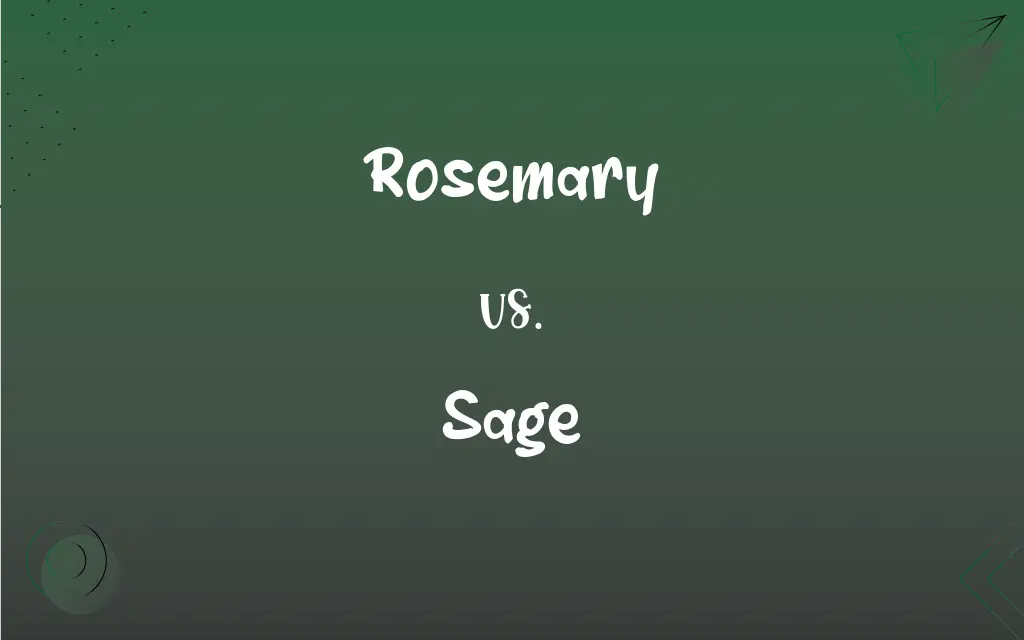Rosemary vs. Sage: What's the Difference?
Edited by Aimie Carlson || By Janet White || Published on February 19, 2024
Rosemary is an aromatic herb with needle-like leaves, known for its piney flavor, while sage is a soft, grayish-green herb with a more earthy and slightly peppery taste.

Key Differences
Rosemary, a member of the Lamiaceae family, is characterized by its needle-like leaves and distinctive pine-like aroma. Sage, also part of the Lamiaceae family, has soft, grayish-green leaves with a slightly fuzzy texture.
Rosemary is widely used in Mediterranean cuisine, often in roasted meats and vegetables. Sage is a staple in many European and American dishes, especially in stuffings, sausages, and with poultry.
Rosemary has a strong, piney, and somewhat lemony flavor, making it a bold addition to dishes. Sage offers an earthy, slightly peppery taste with hints of mint, suitable for more subtle flavoring.
Rosemary is known for its potential cognitive and circulatory benefits and is used in aromatherapy. Sage has been traditionally used for its digestive and anti-inflammatory properties, and also as a natural preservative.
Rosemary has a history of use in folklore and traditional medicine, symbolizing remembrance. Sage has been used in various cultures for culinary, medicinal, and even ritual purposes, symbolizing wisdom.
ADVERTISEMENT
Comparison Chart
Botanical Characteristics
Needle-like leaves, pine-like aroma
Soft, grayish-green leaves, fuzzy texture
Culinary Uses
Roasted meats, Mediterranean dishes
Stuffings, sausages, poultry
Flavor Profile
Strong, piney, lemony
Earthy, slightly peppery, minty
Medicinal Uses
Cognitive, circulatory benefits, aromatherapy
Digestive aid, anti-inflammatory, preservative
Cultural Significance
Symbolizes remembrance, folklore
Used in rituals, symbolizes wisdom
ADVERTISEMENT
Rosemary and Sage Definitions
Rosemary
An aromatic herb with needle-like leaves, used in cooking and aromatherapy.
I added rosemary to the lamb roast for a flavorful crust.
Sage
Commonly used in European and American cuisine.
Sage and onion make a classic flavor combination.
Rosemary
Used both fresh and dried in culinary applications.
Fresh rosemary sprigs garnished the dish beautifully.
Sage
Valued for its digestive and anti-inflammatory properties.
Sage tea is a traditional remedy for sore throats.
Rosemary
Known for its pine-like aroma and flavor.
The piney scent of rosemary filled the kitchen.
Sage
A soft, grayish-green herb with a slightly peppery taste.
Sage was the key herb in the Thanksgiving stuffing.
Rosemary
Has potential cognitive and circulatory health benefits.
Rosemary tea is believed to be good for mental clarity.
Sage
Used both fresh and dried in various dishes.
I sprinkled dried sage over the chicken before roasting.
Rosemary
Often associated with remembrance and folklore.
In folklore, rosemary was used to enhance memory.
Sage
Historically used in rituals and symbolizes wisdom.
Sage has been used in ceremonial practices for centuries.
Rosemary
An aromatic evergreen Mediterranean shrub (Rosmarinus officinalis) in the mint family, having light blue or pink flowers and narrow grayish-green leaves that are used in cooking and perfumery.
Sage
One venerated for experience, judgment, and wisdom.
Rosemary
The leaves of this plant used as a seasoning.
Sage
Any of various plants of the genus Salvia of the mint family, especially S. officinalis, having aromatic grayish-green leaves.
Rosemary
A shrub, Salvia rosmarinus (formerly Rosmarinus officinalis), that originates from Europe and Asia Minor and produces a fragrant herb used in cooking and perfumes.
Rosemary
A labiate shrub (Rosmarinus officinalis) with narrow grayish leaves, growing native in the southern part of France, Spain, and Italy, also in Asia Minor and in China. It has a fragrant smell, and a warm, pungent, bitterish taste. It is used in cookery, perfumery, etc., and is an emblem of fidelity or constancy.
There's rosemary, that's for remembrance.
Rosemary
Widely cultivated for its fragrant gray-green leaves used in cooking and in perfumery
Rosemary
Extremely pungent leaves used fresh or dried as seasoning for especially meats
FAQs
Is rosemary good for health?
Rosemary is believed to have cognitive and circulatory health benefits.
Can sage be used in teas?
Yes, sage is often used in teas for its potential health benefits.
What is sage?
Sage is a soft, grayish-green herb known for its earthy and slightly peppery flavor.
Is sage beneficial for health?
Sage has been traditionally used for its digestive and anti-inflammatory properties.
Can sage be used fresh and dried?
Sage is versatile and can be used both fresh and dried in cooking.
Can rosemary be used fresh and dried?
Yes, rosemary is used both in its fresh and dried forms.
How is rosemary used in cooking?
Rosemary is often used in roasted meats, vegetables, and Mediterranean dishes.
Does rosemary have a symbolic meaning?
Historically, rosemary symbolizes remembrance and is used in folklore.
How does rosemary's flavor compare to other herbs?
Rosemary has a strong, piney flavor, distinct from most other herbs.
Is rosemary easy to grow?
Rosemary is a hardy herb and can be grown relatively easily.
What is rosemary?
Rosemary is an aromatic herb with needle-like leaves, used in cooking and traditional medicine.
What dishes is sage commonly used in?
Sage is frequently used in stuffings, sausages, and with poultry.
Does sage have a cultural significance?
Sage has been used in various cultures for rituals and symbolizes wisdom.
What is the best way to use fresh sage in cooking?
Fresh sage is great in savory dishes, especially with meats and vegetables.
How does the flavor of sage change when cooked?
Cooking sage can mellow its flavor, making it less pungent.
What are the medicinal uses of rosemary?
Rosemary is used in aromatherapy and may support cognitive health.
Is sage used in any traditional remedies?
Sage is traditionally used in remedies for sore throats and digestion.
How should sage be stored for cooking?
Sage should be stored in a cool, dry place; fresh sage can be refrigerated.
Can rosemary be used in desserts?
Yes, rosemary can be used in some desserts for a unique flavor.
What are the best pairings for rosemary in cooking?
Rosemary pairs well with lamb, chicken, potatoes, and bread.
About Author
Written by
Janet WhiteJanet White has been an esteemed writer and blogger for Difference Wiki. Holding a Master's degree in Science and Medical Journalism from the prestigious Boston University, she has consistently demonstrated her expertise and passion for her field. When she's not immersed in her work, Janet relishes her time exercising, delving into a good book, and cherishing moments with friends and family.
Edited by
Aimie CarlsonAimie Carlson, holding a master's degree in English literature, is a fervent English language enthusiast. She lends her writing talents to Difference Wiki, a prominent website that specializes in comparisons, offering readers insightful analyses that both captivate and inform.































































